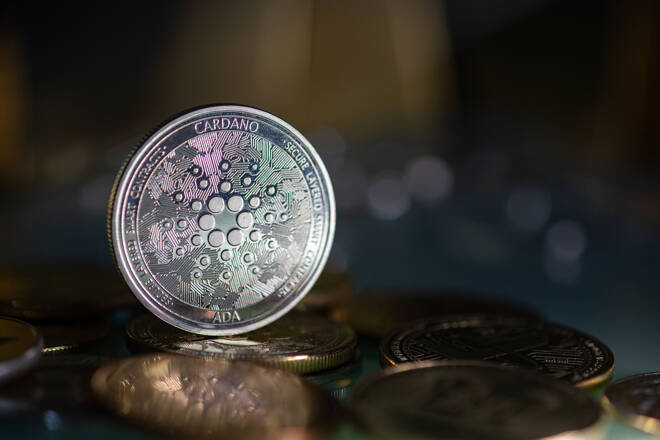Advertisement
Advertisement
ADA Price Prediction: Bears Eye Sub-$0.320 on Crypto Scrutiny
By:
It was a bearish Friday for ADA. Input Output HK network updates failed to impress, leaving Silvergate Bank news to deliver sub-$0.30.
Key Insights:
- ADA joined the broader crypto market in the red on Friday, sliding by 2.28% to end the session at $0.343.
- Crypto market reaction to the news of the leading crypto platform cutting ties with Silvergate Bank sent ADA and the broader crypto market into a tailspin.
- The technical indicators remained bearish, bringing sub-$0.320 into play.
ADA fell by 2.28% on Friday. Following a 2.50% loss on Thursday, ADA ended the day at $0.343. The bearish session saw ADA visit sub-$0.330 for the first time since January 19.
A bearish start to the day saw ADA tumble from an opening price high of 0.351 to an early morning low of $0.321. ADA fell through the First Major Support Level (S1) at $0.343 and the Second Major Support Level (S2) at $0.336. However, steering clear of the Third Major Support Level (S3) at $0.319, ADA broke back through S2 to end the day at $0.343. S1 capped the upside late in the session.
Silvergate Bank Updates Leave IOHK Updates on the Sidelines
On Friday, news of crypto clients severing ties with Silvergate Bank shook investor sentiment. Leading crypto exchanges, including Coinbase, Crypto.com, Paxos, and Bitstamp, cut ties with the crypto-friendly bank.
The move came in response to the bank delaying its annual report filing on Wednesday, leading to speculation that the bank may be on the brink of collapse.
Alarmingly, Silvergate Bank stated,
“The Company is evaluating the impact that these subsequent events have on its ability to continue as a going concern for the twelve months following the issuance of its financial statements.”
The news overshadowed a bullish NASDAQ Composite Index session. On Friday, the NASDAQ rallied by 1.97% on hopes of the Fed taking interest rates up slow and steady. Economic data from the US was also bullish, with the all-important ISM Non-Manufacturing PMI seeing a modest decline from 55.2 to 55.1.
IOHK Weekly Development Update Disappoints Again
Input Output HK (IOHK) released the Weekly Development Report on Friday.
According to the March 3 report,
- 117 projects launched on the Cardano network, unchanged from February 24.
- Projects building on the Cardano network totaled 1,209, up by four from the previous report.
- Plutus scripts totaled 5,953, of which 797 were Plutus V2 scripts. As of February 24, Plutus scripts stood at 5,857.
Before the Vasil hard fork, the number of projects launched on Cardano had stood at 98, with 1,100 projects building on the Cardano network.
Other stats included 62.2 million transactions (Previous Report: 61.8m), 7.87 million native tokens (PR: 7.83 million), and 70,258 token policies (PR: 70,039).
The modest increase in project numbers failed to distract investors from the broader crypto market turmoil.
The Day Ahead
Input Output HK updates will draw attention. However, Binance, FTX, and Silvergate Bank news and further updates from the ongoing SEC v Ripple case will likely have more influence.
Following the increased scrutiny from US lawmakers and the SEC, investors should also monitor US lawmaker chatter and regulatory activity.
ADA Price Action
This morning, ADA was down 0.29% to $0.342. A mixed start to the day saw ADA rise to an early high of $0.347 before falling to a low of $0.342.
Technical Indicators
ADA has to avoid the $0.338 pivot to target the First Major Resistance Level (R1) at $0.356. A move through the Friday high of $0.351 would support a bullish session. However, Cardano network updates and the broader crypto market would need to provide support.
In case of a breakout, ADA would likely test the Second Major Resistance Level (R2) at $0.368 and resistance at $0.370. The Third Major Resistance Level (R3) sits at $0.398.
A fall through the pivot ($0.338) would bring the First Major Support Level (S1) at $0.326 into play. However, barring another extended broad-based crypto sell-off, ADA should avoid sub-$0.320 and the Second Major Support Level (S2) at $0.308. The Third Major Support Level (S3) sits at $0.278.
Today, the EMAs and the 4-hourly candlestick chart (below) sent bearish signals.
ADA sat below the 50-day EMA, currently at $0.359. The 50-day EMA pulled back from the 100-day EMA, with the 100-day EMA easing back from the 200-day EMA, delivering bearish signals.
A move through R1 ($0.356) and the 50-day EMA ($0.359) would support a run at R2 ($0.368) and the 100-day ($0.369) and 200-day ($0.370) EMAs. However, failure to move through the 50-day EMA ($0.359) would leave the Major Support Levels in play. A move through the 50-day EMA would send a bullish signal.
About the Author
Bob Masonauthor
With over 28 years of experience in the financial industry, Bob has worked with various global rating agencies and multinational banks. Currently he is covering currencies, commodities, alternative asset classes and global equities, focusing mostly on European and Asian markets.
Advertisement
